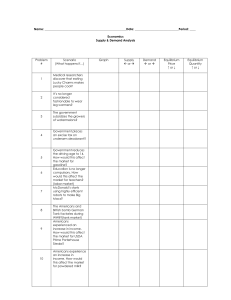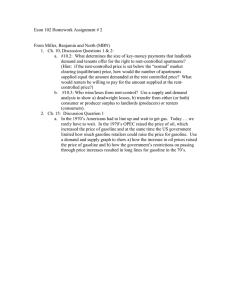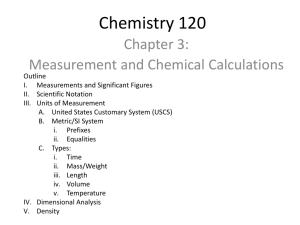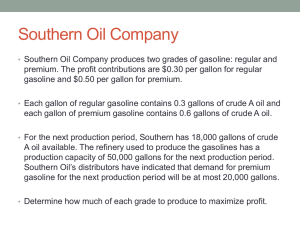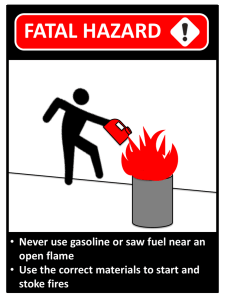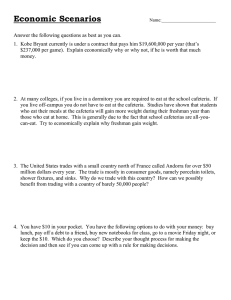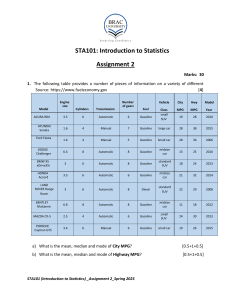Economics 471 Midterm Review: CAPM, Engel Curves, Demand
advertisement
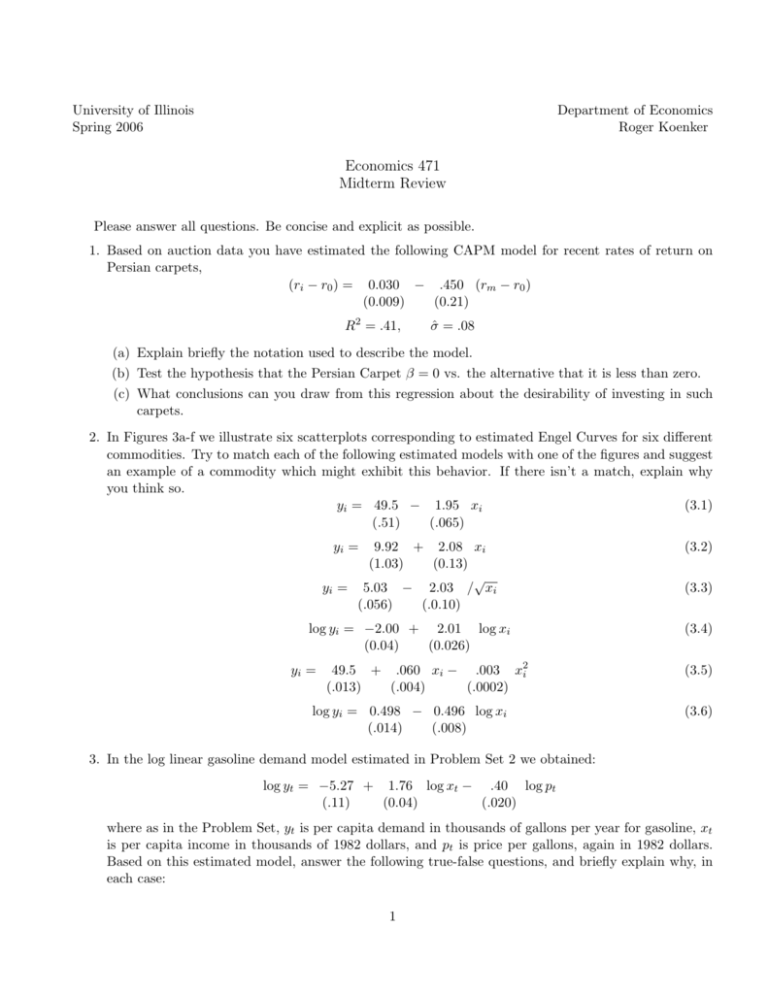
University of Illinois Spring 2006 Department of Economics Roger Koenker Economics 471 Midterm Review Please answer all questions. Be concise and explicit as possible. 1. Based on auction data you have estimated the following CAPM model for recent rates of return on Persian carpets, (ri − r0 ) = 0.030 − .450 (rm − r0 ) (0.009) (0.21) R2 = .41, σ̂ = .08 (a) Explain briefly the notation used to describe the model. (b) Test the hypothesis that the Persian Carpet β = 0 vs. the alternative that it is less than zero. (c) What conclusions can you draw from this regression about the desirability of investing in such carpets. 2. In Figures 3a-f we illustrate six scatterplots corresponding to estimated Engel Curves for six different commodities. Try to match each of the following estimated models with one of the figures and suggest an example of a commodity which might exhibit this behavior. If there isn’t a match, explain why you think so. yi = 49.5 − 1.95 xi (3.1) (.51) (.065) yi = 9.92 + 2.08 xi (1.03) (0.13) √ yi = 5.03 − 2.03 / xi (.056) (.0.10) (3.2) log yi = −2.00 + 2.01 log xi (0.04) (0.026) (3.4) yi = 49.5 + .060 xi − .003 x2i (.013) (.004) (.0002) log yi = 0.498 − 0.496 log xi (.014) (.008) (3.3) (3.5) (3.6) 3. In the log linear gasoline demand model estimated in Problem Set 2 we obtained: log yt = −5.27 + 1.76 log xt − .40 log pt (.11) (0.04) (.020) where as in the Problem Set, yt is per capita demand in thousands of gallons per year for gasoline, xt is per capita income in thousands of 1982 dollars, and pt is price per gallons, again in 1982 dollars. Based on this estimated model, answer the following true-false questions, and briefly explain why, in each case: 1 a b 50 ● ● ● ● ● ● ● ●● ●● ● ● ● 30 ● ● ● ● ● ● ● ● ● ● ● ● ● ● ● ● ● ● ● ● ● ● ● ● 20 y 40 ● ●● ● ● ● 30 ● ● ●● ● ● ● ● ● ● ● ● ● ● ● 10 15 ● ●● ● ●● ● ● ● ● ● ● ● ● ● ● ● ●● ● ● ● ● ● ● ● ● ● ● ● ● ●● ● ● ● ● ● ● ●● ● ● ● ● ● ● ● ●● ● ● ● ● ● ● ● ● ● ● ● ● ●● ● ● 10 ● ● ● ● ● 5 ● ● ● ● ● ● ● ● ● ● ● ● ● ● ● 20 5 10 x c d 15 x 20 ● ● ● ●● ● 50 ● ● 20 ● ● ● ● ●● 0 20 10 x x e f 15 20 ● ● ● ● ●● ●● ● ● ● ● ● 1.6 ● ● ● ● ● ● ● ● ● ● ● ● ● ● ● ● ● ● 1.2 ● ● ● ● ● ● ● y ● 49.9 ● ● ● ● ●● ●●● ●● ● ● ● ●● ●● ● ● ●● ● ● ● ●● ● ●● 0.8 ● ●● ● ● 49.7 ● ● ● ●● ● ● ● ● ● ●● ● ● ● ● ● ● ● ● 10 15 ●● ● ● ● ●● ●● ●●● ●● ● ● ● ●● ● ● ● ● ● ● ● 0.4 ● 5 ● ● ●● ● ● 5 ● ● ● ● ● ● ● ● ● ● ●●● ●● ● ● ● ●● ● ● ● ● ● ● ●● ●● ● ●● ● ● ● ●● ● ● ● ● ● ● ● ● ● ● ● ●● ● ●● ● ● ●● ● ● ● ● ● ● ● ● ● ●●●● ●●● ● ● ● ● ● ● ● ●● ● ● ●● ● ●● ● ●● ●● ●●● ● ● ●● ●● ● ●● ● ● ● ● ● ● ● ● ● ● ● ● ● ● 15 ● ● ● ● ● ● ● ● ● 50.3 50.1 ● ● ● 10 ● ● ● ● ● ● ● ● ● ● 5 y ● ● ● ● ● 10 ● ● ● ● ●● ● ●● ● ● ●● ● ● ● ● ●● ● ● ●● ● ●● ● ● ●● ●● ● y 4.0 3.5 ● ● ● ● ● ● ● ● ● ● ● ●● ● ● ● ● ● ● ● ● ● ● ● ● ● ● ● ● 40 ● ● ● ● 3.0 ● ● ● ● y ● 30 4.5 ● ● ● ● ● ● ● ● ● ● 20 ● ● ● ● ● ●● ●● ● ● ● ● ●● ●● ● ● ● ● ●●● ● ● ● ● ● ● ● ●● ● ● ● ● ● ●● ● ● 10 ● ●● y 40 50 ● ●● 20 5 x ●● ● 10 x Figure 1: Six scatterplots and their fitted relationship. 2 ● ● ● ● ● ● ● ● ● ● 15 ● ● ● 20 (a) As income rises the average American spends more of his income on gasoline. (b) As income rises the average American spends a larger proportion of his income on gasoline. (c) At the conventional α = .05 level we can not reject the hypothesis that the price elasticity of gasoline is − 12 . (d) Raising the price of gasoline by 1% would be expected to increase the total amount spent on gasoline. (e) Doubling the price of gasoline would be expected to decrease the amount spent on gasoline. Now consider the alternative model also estimated in PS 2: log yt = −7.39 + 2.57 log xt − 2.57 log pt − .271 (log pt )2 + .717 (log pt log zt ) (.20) (0.08) (.19) (.04) (.06) (f) Describe briefly why this model is better than the first one emphasizing both statistical and economic criteria. 3
